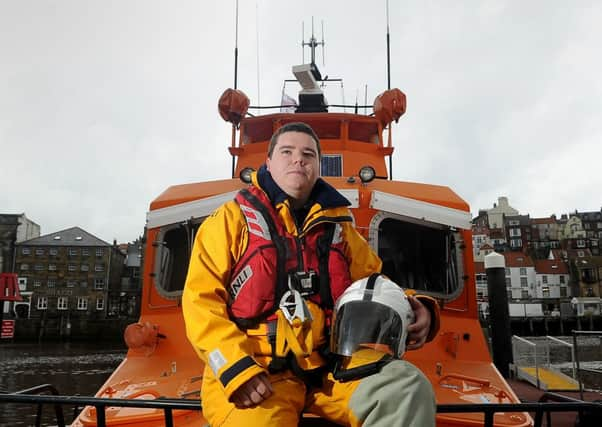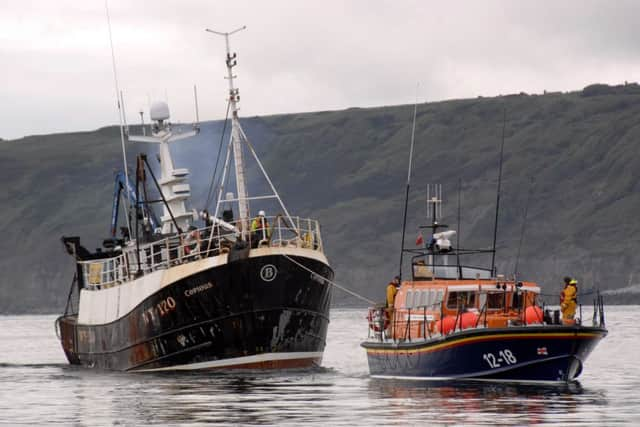A long history of heroism


THERE’S a powerful sense of history at Whitby Lifeboat Station, as befits its setting at the heart of a port steeped in tradition.
The town’s lifeboat, George and Mary Webb, is the most immediately visible on the Yorkshire coast, kept permanently afloat in the harbour, her vivid orange paintwork catching the eyes of the visitors who stroll along the quays.
Advertisement
Hide AdAdvertisement
Hide AdAnd there are reminders of the lifesaving tradition she represents everywhere, in the sepia Frank Meadow Sutcliffe portraits of lifeboatmen from the 19th and early 20th centuries which feature on postcards and in framed photographs, images as redolent of Whitby as the Abbey or St Mary’s Church.


The past captured in those photographs regularly reaches out to touch the station. One of the best-known portraits is of Henry Freeman, the only survivor of the Whitby lifeboat disaster of February 9, 1861, when it capsized in a ferocious storm that wrecked more than 200 ships on the east coast. The lifeboat was on its sixth rescue attempt that day when it was lost and 12 crewmen died.
Freeman owed his life to a newly-designed cork lifejacket, which he wears in the Sutcliffe portrait. He went on wearing it, serving as the lifeboat coxswain for more than 20 years and helping to save more than 300 lives.
And more than a century-and-a-half on from one of the grimmest days in Yorkshire’s maritime history, Freeman’s descendants continue to turn up at the lifeboat station to pay their respects. “It’s amazing how many relatives he has,” said Glenn Goodberry, the full-time mechanic and 31 years a member of the crew. “There are still people out there connected to him, and connected to Whitby. Some of them have chased up their family trees, and they come in and tell us they’re his relatives.”
Advertisement
Hide AdAdvertisement
Hide AdThe past that Freeman represents is especially vivid, because the hazards he faced in the stormy seas off Whitby, lashed by winds from the north and squalls that overtake vessels, can still catch the lifeboat out. The crew of 2013 heading out of the safety of the harbour face the same conditions he did. “There have been occasions when we’ve got out, but not been able to come home,” says Glenn, 54. “We’ve had to go to Scarborough or north to the Tees.”
Remembrance of another great storm, and the proud lifesaving history of Whitby, looms on the horizon for the station. The 1914 rescue of a wrecked hospital ship, the Rohilla, when 144 people were plucked from a raging sea is to feature in an RNLI touring exhibition to commemorate the centenary of the First World War.
The Rohilla struck Whitby Rock, south of the harbour, on October 30, 1914 on her way to Dunkirk to pick up wounded. What followed was one of the most epic rescues in RNLI history.
Although the stricken ship was only a few hundred yards offshore, high seas prevented the lifeboat leaving the harbour, so the people of the town turned out in fearsome weather and manhandled her over the sea wall and rocks to launch from the beach. Five other lifeboats joined the rescue effort, which continued for 50 unrelenting hours in storm-force winds.
Advertisement
Hide AdAdvertisement
Hide AdThey were unable to save 85 souls, but the toll of lives lost would have been much higher had it not been for the astonishing bravery and tenacity of the lifeboat crews. Among those rescued was probably the luckiest person aboard – Mary Roberts, who two years earlier had also survived the sinking of the Titanic.
There will be a service of commemoration in Whitby to mark the anniversary, and the station is contacting relatives of those involved – the rescued, as well as those who helped to save lives. It’s another reminder of the lifeboat’s long tradition, and also how closely the town holds it to its heart. The George and Mary Webb has been part of Whitby since 1996, and its station is the most modern on the Yorkshire coast, built in 2007 to replace the lifeboat house dating from 1914.
The lifeboat chaplain is the Rector of Whitby, David Smith, who said: “The lifeboat is the town, it’s been here for over 200 years, and there are that many of the old fishing families who are part of the lifeboat. Everybody has grown up with it, the town has grown up with it, because when we first had a lifeboat here the town was a lot smaller, so it’s always been a part of the town.”
Always a part of Whitby people, too. There are some long personal histories associated with the lifeboat, like that of Ada Myers, 80, who first started fundraising for it by selling her toys as a child during the Second World War. She’s still a regular visitor to the station despite not being as mobile as she once was, sometimes bringing home-made cakes and still raising money.
Advertisement
Hide AdAdvertisement
Hide AdAda is a familiar figure to both the people of the town and visitors on fund-raising days, when she sits at the foot of the 199 steps leading up the Abbey, clad in traditional Staithes bonnet, encouraging everyone to leave a donation for the lifeboat on each step of the long climb.
“We have great fun on those steps raising money,” she says. “People come from far and near, and the weather doesn’t matter. I’ve been sat on those steps in my Staithes bonnet when it’s been blowing a gale.
“We used to sell our toys during the war to raise money to put in the lifeboat box. It’s an honour to be able to raise money for these boys who risk their lives every time they go out. The lifeboat means everything to Whitby, it’s at the centre of the town, it’s always to the fore.”
It was always in the forefront of Dave Harcourt’s mind as well. He’s the crew’s newest member, a 39-year-old builder’s merchant. “I grew up in Staithes, so we often used to go running down to the bottom when the maroons went up, so I’ve always been around the lifeboat,” he explains.
Advertisement
Hide AdAdvertisement
Hide AdThe changing nature of sea use means new challenges for the lifeboat. Whitby’s fishing fleet has shrunk, but there are more leisure craft, and they – and the people who own them – sometimes need help. “Commercial boats, because they’re being used all the time, tend to suffer less from mechanical failures, but on a machine that’s stood still for six months things can go wrong,” says Glenn. “A lot of boats arrive on the back of a trailer, and they get out to sea and they have problems.”
The emergencies that the crew encounter can take a personal toll. Earlier this year, they dealt with a severely burned merchant seaman after a fire on board his ship. “Our crew are all volunteers,” says Glenn. “And sometimes they have to deal with some very nasty experiences, and sometimes they do need to talk to people, but we are a family, and we tend to sort our problems out in house.”
Chaplain David Smith is one of the people they talk to. “It’s part of the parish, so it was a natural thing for me to get on board. It’s a thing of just listening and being here. We’ve had some nasty jobs, and then you try to listen and help.”
Generations of Whitby lifeboat crew have been helping since Henry Freeman’s time and before. It’s the tradition.
Advertisement
Hide AdAdvertisement
Hide AdAnd some other things have never changed, either, in this seafaring community that knows how fickle and treacherous the North Sea can be. “I was born by the sea, lived most of my life by it, and it’s a wonderful thing,” says David. But it changes and sometimes people don’t realise how quickly it changes. Sometimes when the lifeboat’s off, I do sit and think and pray for the crew.”
Next week: Filey